ASUS P5Q3 Deluxe: An Early Preview of P45 Express Performance
by Kris Boughton on May 13, 2008 2:00 PM EST- Posted in
- Motherboards
Board Layout and Features
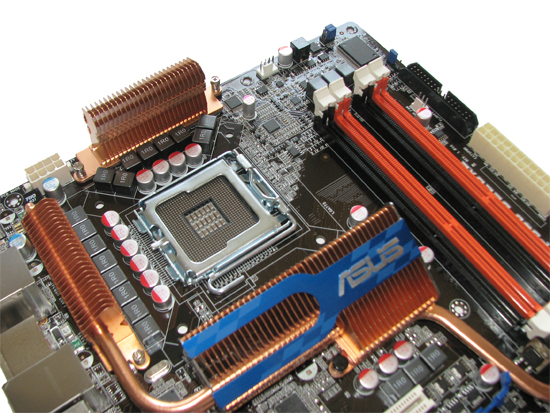
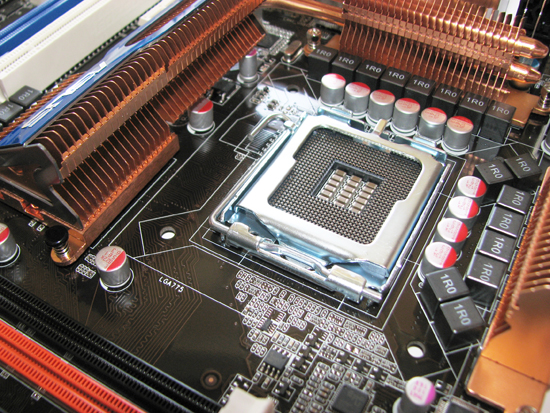


The P5Q3 may report the use of a 16-phase PWM but we know better. Although ASUS design engineers have added a lot of extra chokes and MOSFETS, the overall capacity of the power delivery circuit remains comparable to their competitors' more modest 8-phase designs. One thing's for certain, we can all agree that more phases do not necessarily make for a more stable power subsystem. Although we did not experience any problems with this particular solution we would rather see ASUS concentrate their efforts on designing an entirely new circuit based on a true 6-phase PWM.
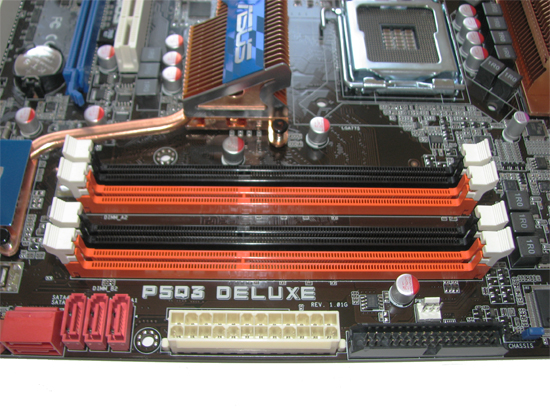
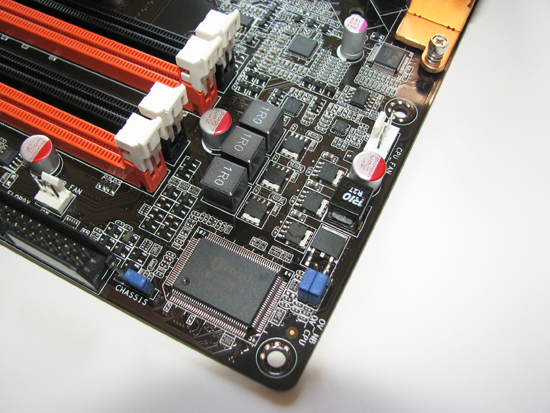
The DDR3 power circuit is a 3-phase design, just like the P5E3 Premium, and the board has no problems clocking memory to speeds of DDR3-2000 and higher. We recommend you place your modules in the orange slots first and populate the black slots only as needed. Because of the way DDR3 signals are terminated on the modules themselves, it is often possible to coax maximum speed from the system with the memory in this configuration.

The all-copper heatsink is both functional and aesthetically pleasing. ASUS was also wise to include back plates for the portions of the cooler covering the power MOSFETs and mounting screws to tightly secure the assembly to the board.
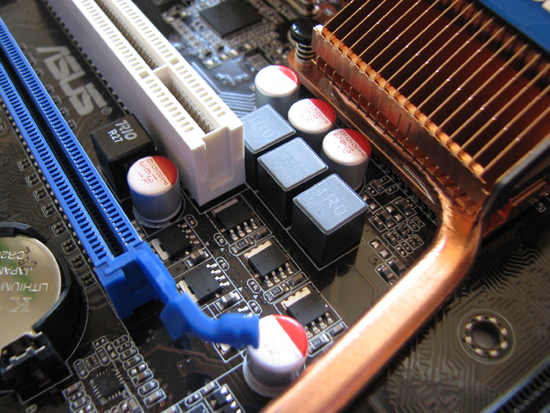
ASUS engineers have taken their MCH power delivery system one step further than before; the P5Q3 now features a 3-phase design whereas the P5E3 Premium used a 2-phase solution. Thanks to the relatively low power requirement of the MCH, active cooling is not necessary for any of these MOSFETs, although it could not hurt if you decided to customize your board by placing extra sinks on the hotter components.
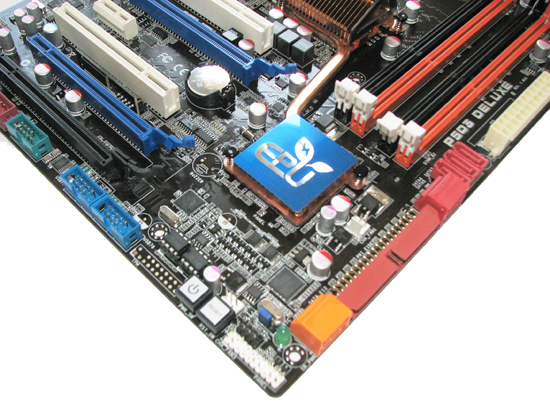
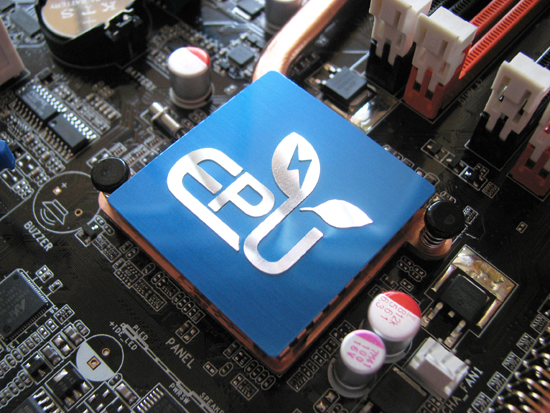
The five red SATA ports are electrically connected to the ICH10(R) Southbridge with the sixth present in eSATA form, located on the board's back panel. A JMicron JM363 host controller provides an additional two SATA ports (orange), capable of RAID 0, 1 and JBOD operation, as well as a single PATA port for legacy IDE hard disk or optical disc support. Integrated power and reset momentary tactile switches can been seen in the corner of the board. The lone green LED is the only indication that the board is powered - be sure to pay attention to the state of this light whenever removing or inserting any components.
The ICH10R is covered by a custom two-piece heatsink and is thermally coupled to the MCH and half the bank of CPU power MOSFETs via a single heatpipe. It would have made sense to include the other MOSFET cooler but the placement of the ATX12V+ power connector might have made this difficult. The cobalt blue cover is adorned with an artistic "EPU" logo and represents the incorporation of ASUS' Energy Processing Unit technology that seeks to maximize overall system power savings during periods of light CPU loading by selectively enabling and disabling power delivery phases for the most efficient operation possible. Our lab results show the savings to be small yet measurable.
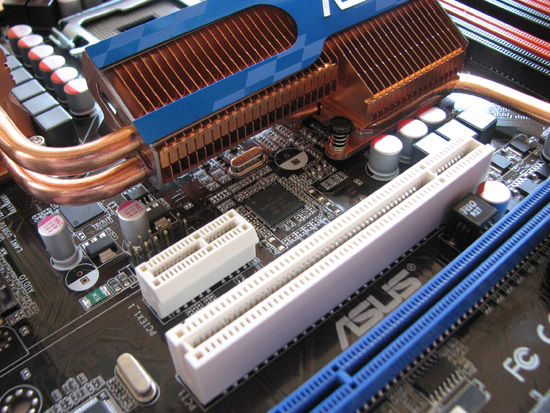
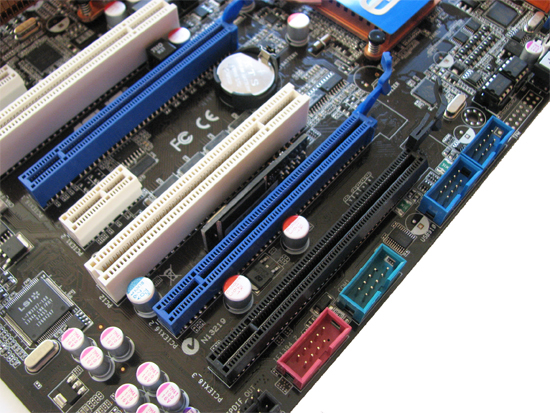
The P5Q3 Deluxe includes support for up to three PCIe x16 cards. The two blue slots are fully PCIe 2.0 compliant and hang off the P45 Northbridge. They can be configured for either 1x16 or 2x8 operation, depending on the number of cards installed. The bottom black slot is PCIe 1.x compatible only and is serviced by the ICH10R Southbridge. While the slot can mechanically seat x16 cards the maximum electrical connection is just x4 due to the lack of available lanes. For maximum performance, populate the blue slots before working with the last black one.
Two PCIe x1 slots (1.x compatible) and a pair of legacy PCI slots round out the board's expansion capabilities. Overall, we prefer the P5Q3 Deluxe expansion slot layout over that offered by the P5E3 Premium. Unlike the X48 board, this P45 board provides double spacing between the two primary PCIe 2.0 slots.










30 Comments
View All Comments
dingetje - Tuesday, May 13, 2008 - link
a p45 shootout article would be awesome.i won't buy asus anymore because of their EPU scam, but am very interested in the gigabyte and msi p45 offerings
Hxx - Wednesday, May 14, 2008 - link
Asus = EPU scam, Gigabyte = dynamic energy saver scam. Unless your running your system at stock speeds, these features are useless, which brings out the following question? why are these 2 embedded in high end motherboards?Hulk - Tuesday, May 13, 2008 - link
I've written this before but a lot of people (like myself) might be considering this board as a big upgrade from an older board, like my current P5B Deluxe rig. Please include some "legacy" benchmarks so we can see if the performance improvements are worth the dimes.hansmuff - Tuesday, May 13, 2008 - link
Certainly the P35 is mature by now and will be eclipsed, but I'd like to see a consideration of performance/$.A good P35 board is $120, 4GB of name brand DDR2-800 with an 8GB option (2x2GB) is $85. I can't even buy this P45 for those two combined, so DDR3 cost really comes into play.
Frumious1 - Tuesday, May 13, 2008 - link
Well, you can't even buy any P45 boards right now, so it's a bit premature to discuss retail prices. This particular board is DDR3, so for budget-conscious buyers it would probably be a poor choice. ASUS will have a DDR2 model as well, and so will other companies. How much will those boards cost and how will they perform relative to, say, X38 DDR2 boards? Or P965, 975X, and P35 DDR2 boards? Those are all things we will hopefully examine in a future article. (Not being the motherboard reviewer, I can't make any promises. :))Hxx - Wednesday, May 14, 2008 - link
This board doesn't look "mainstream" to me for a 250 dollar board. I know that intel boards can go as high as 500 bucks a piece but a mainstream board is a stripped down of all the features such as dual ethernet, wireless build in, etc, and this board has it all, except maybe watercooling blocks. But anyway, just like the author stated, a major shift to a different socket type and processing power si drawing near, hopefully by the end of this year aka nehalem, which will pretty much make the x38/48 and p35/45 series become obsolete. So this board is definitely not futureproof. Having said that, most enthusiast/mainstream users will skip this product and look further ahead to the coming up nehalem processors. As for people looking to upgrade or building a new system, P35 can be had for less than $100 without sacrificing too much performance, or x38 for under 200 for crossfire purposes.P45 will only increase Intel's revenues without bringing anything new or worthy of attention to us, the consumers.
JarredWalton - Wednesday, May 14, 2008 - link
$249 as an estimated price prior to launch is not indicative of the market as a whole. I imagine we'll see P45 boards at much more reasonable prices - they should only carry a small premium over P35 boards really.You can also see updated results with P35 performance in the charts now, and from that it's quite clear that P45 isn't a major leap forward. We'll have to wait for further tests on stuff like CrossFire, as that might show more of an advantage, but unless P45 comes in at a price lower than X38 it won't really be a huge chipset launch. Luckily, I expect we will see $150 and lower priced P45 boards - just probably not from ASUS. ;-)
Hxx - Wednesday, May 14, 2008 - link
Wow, performance difference between p45 and p35 is so small it's scary. One might state that P45 is just a refresh of its older brother, which is not.Frumious1 - Tuesday, May 13, 2008 - link
Edit: *they* will hopefully examine. Whatever. I know that's what I want to see benchmarked.goosemilk - Tuesday, May 13, 2008 - link
Does this board support Crossfire and SLi?